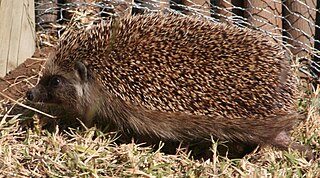
The gayal, also known as the Drung ox or mithun, is a large domestic cattle distributed in Northeast India, Bangladesh, Myanmar and in Yunnan, China.

The white-browed scrubwren is a passerine bird found on the New England Tablelands and coastal areas of Australia. Placed in the family Pardalotidae in the Sibley-Ahlquist taxonomy, this has met with opposition and indeed is now known to be wrong; they rather belong to the independent family Acanthizidae.

The Arctiini are a tribe of tiger moths in the family Erebidae.

The Southern African hedgehog is a species of mammal in the family Erinaceidae. It is found in Angola, Botswana, Lesotho, Namibia, South Africa, Tanzania and Zimbabwe.
Acanthofrontia is a genus of erebid moths in the subfamily Arctiinae with Afrotropical distribution. It was described by George Hampson in 1910.

Amyna is a genus of moths of the family Noctuidae erected by Achille Guenée in 1852.
Satronia is a New World genus of tortrix moths belonging to the subfamily Olethreutinae and tribe Grapholitini. The genus was erected in 1926 by Carl Heinrich and was previously considered monotypic. Its type species is Satronia tantilla.

Aithorape is a genus of moths in the family Megalopygidae.
Oedaleosia frontalis is a moth of the subfamily Arctiinae. It was described by Strand in 1909. It is found in eastern Africa.
Carohamilia ophelia is a moth in the family Cossidae. It is found in Guatemala.
Exaeretia gracilis is a moth in the family Depressariidae. It was described by Lord Walsingham in 1889. It is found in North America, where it has been recorded from North Dakota to Texas and in California, Colorado, Minnesota, Oklahoma, Wisconsin and Iowa.
Exaeretia sordidella is a moth in the family Depressariidae. It is found in North America, where it has been recorded from British Columbia.
Inga crucifera is a moth in the family Oecophoridae. It was described by August Busck in 1914. It is found from Panama to Peru.
Inga roseomarginella is a moth in the family Oecophoridae. It was described by August Busck in 1911. It is found in French Guiana.
Aithorape albicostata is a moth of the family Megalopygidae. It was described by Walter Hopp in 1927. It is found in Trinidad, Brazil and Paraguay.
Aithorape spinulata is a moth of the family Megalopygidae. It was described by Walter Hopp in 1927. It is found in Peru.
Aithorape analis is a moth of the family Megalopygidae. It was described by Walter Hopp in 1930. It is found in Brazil.

Aithorape roseicornis, Dognin's satin, is a moth of the Megalopygidae family. It was described by Paul Dognin in 1899. It is found in Colombia, Ecuador and Peru, where it inhabits rainforests and cloudforests at altitudes between 200 and 1,200 meters.
Megalopyge ravida is a moth of the family Megalopygidae. It was described by Herbert Druce in 1887. It is found in Mexico.

Podalia orsilochus is a moth of the Megalopygidae family. It was described by Pieter Cramer in 1775. It is found in Mexico, Costa Rica, Brazil, Guyana and Venezuela.






